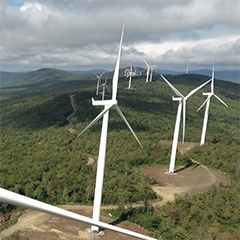Danny Ellis, CEO and co-founder of SkySpecs, dropped in to PES to give us the latest on the different maintenance strategies and why he thinks his company has the best proposition.
PES: Welcome back to PES Wind magazine. It’s great to talk with you again. For the benefit of our new readers would you like to begin by explaining a little about the background of SkySpecs and the importance of the wind industry to you?
Danny Ellis: SkySpecs is focused on wind turbine blade diagnostics and maintenance, providing robotic technology that completely automates the visual inspection, analysis, and prescription maintenance of blades with drones. Our inspections take 15 minutes or less per wind turbine, and we inspect all four sides of all three blades in a single flight without any manipulation of the wind turbine.
We do not require any prior information about the wind turbine because the drone is programmed to identify and learn about the turbine when it takes off. This streamlined approach allows us to conduct around 25 turbine inspections, with a single drone, in one day.
SkySpecs recently introduced Horizon – an analytics, reporting, and management software platform for the wind energy industry. Horizon allows customers to review, prioritize and optimize their repair campaigns based on predictive maintenance recommendations.
Our differentiator is that we measure and track damage over time, providing insight to our customers about how soon they should expect damage to become severe, or how long they can wait to make repairs.
SkySpecs is based in Ann Arbor, Michigan, but currently operates both onshore and offshore in the U.S., Canada, Europe, and Australia.
PES: Currently are you experiencing more growth in the market?
DE: The wind energy market is continuing to grow at a steady pace, but more importantly for SkySpecs, there is a substantial increase in customers looking for predictive maintenance solutions. Historically, this industry relies on a reactive maintenance strategy where they run turbines until failure. Now, many of our customers realize the advantages of spending time, money, and resources on monitoring and fixing turbines based on data analytics.
Because we’ve been working with leaders in the industry, we’ve had the privilege of collaborating and solving problems beyond just collecting data. It became clear we needed to provide a lean, flexible solution to turn data into decisions. Our customers’ feedback and input shaped our offerings, and we continue to work closely with them to ensure we are providing a tool that helps them work faster and more efficiently when it comes to blade operations and maintenance.



























